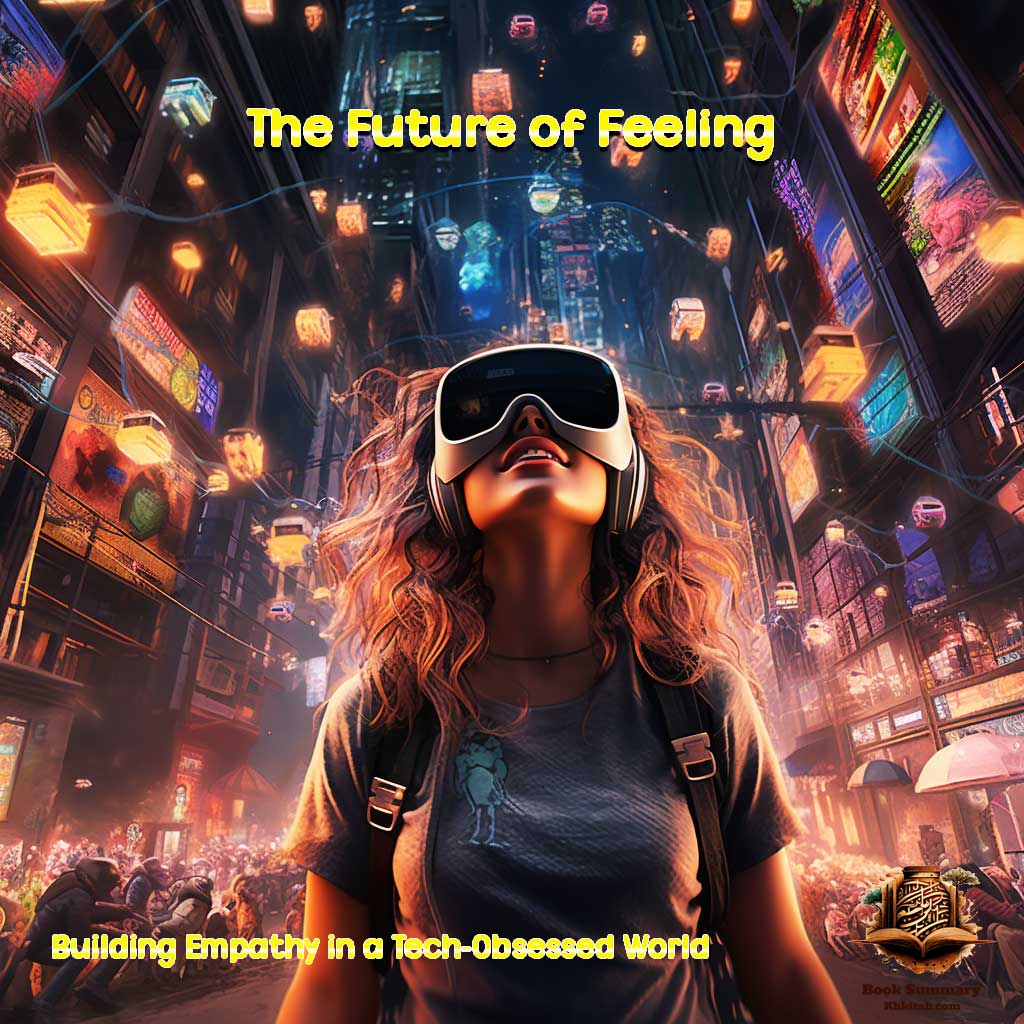The Future of Feeling: Building Empathy in a Tech-Obsessed World Book Summary

In an era characterized by rapid technological advancements, many are in search of deeper meanings and more genuine connections. “The Future of Feeling: Building Empathy in a Tech-Obsessed World” by Kaitlin Ugolik Phillips delves into this very quandary. The book illuminates the challenges and opportunities that arise as we navigate our swiftly digitizing age and its implications on human empathy. Venturing through the realms of virtual reality, social media platforms, and artificial intelligence, it sheds light on how these technologies influence our ability to understand and connect with one another. This introduction serves as a setting of the stage, to understand the intricate dynamics of our relationship with technology in an increasingly interconnected and complex world.
Table of Contents
How Does the Digital Age Influence the Depth of Human Connection? From The Future of Feeling
In the heart of the contemporary digital age, “The Future of Feeling: Building Empathy in a Tech-Obsessed World” by Kaitlin Ugolik Phillips offers a compelling exploration of technology’s profound impact on our human interactions. While the internet, social media, and smartphones have revolutionized communication, bringing people from every corner of the globe into our living rooms, the depth and quality of these interactions are subjects of intense debate.
Technology has presented us with a paradox. On one hand, it provides platforms that foster connection, allowing us to interact with diverse individuals across vast distances in real-time. Such unprecedented access should ideally deepen our understanding and appreciation of diverse cultures, experiences, and viewpoints. Yet, on the other hand, the same platforms can sometimes create an illusion of intimacy. Quick, ephemeral chats, likes, and shares can sometimes overshadow meaningful, in-depth conversations. We’re more connected than ever before, but are we truly engaging with one another on a deeper level?
Phillips’ exploration goes beyond mere surface-level observations. She delves into the nuances of this digital landscape, understanding the subtle shifts in behaviors, expectations, and even the very definition of ‘connection’ in our modern era. The proliferation of short-form content, the instant gratification culture, and the endless scroll mechanisms have changed the pace at which we consume information and engage with others.
In conclusion, “The Future of Feeling” challenges readers to reflect on their digital behaviors and consider the quality of their online interactions. While technology undoubtedly offers opportunities for genuine connection, it also comes with pitfalls that can lead to superficial engagements. Balancing these two facets of our digital existence is key to fostering genuine empathy and deep human connections in a tech-saturated world.
Philosophy and Sociology – Book Summary (khkitab.com)
How Can Virtual Reality Redefine Empathy in Our Tech-Driven World?
In the transformative landscape of digital technology, “The Future of Feeling: Building Empathy in a Tech-Obsessed World” uniquely positions Virtual Reality (VR) at the intersection of tech innovation and human emotion. One of the standout discussions in the book revolves around the transformative power of VR to elevate and redefine our understanding of empathy.
Virtual Reality, often heralded as the frontier of immersive experiences, is more than just a tool for entertainment or gaming. Its capacity to place individuals directly into another person’s perspective, essentially allowing them to “walk in another’s shoes,” is groundbreaking. Imagine, for instance, being able to experience life from the perspective of someone from a different cultural background, or understanding the struggles of a person with a disability through first-person experiences. VR offers this potential, bridging gaps in understanding that traditional methods of communication might fail to address.
Phillips dives deep into the nuances of how VR can foster genuine empathetic connections. By transcending the barriers of language, geography, and even physical limitations, VR creates an environment where emotions and experiences can be felt more directly and profoundly. However, it’s essential to approach with a degree of caution. While VR can be an invaluable tool in building empathy, over-reliance or misuse can lead to a skewed perception of reality, detaching individuals from actual human experiences.
To truly harness the potential of VR in enhancing empathy, it requires a balanced approach — one that combines the technological prowess of VR with the intricate fabric of human emotions. In a world increasingly dominated by screens, “The Future of Feeling” reminds us of the need for genuine human connections and the role that innovations like VR can play in achieving that ideal.
Can Social Media Truly Foster Genuine Empathy in Our Tech-Driven Era?
In today’s digital age, as dissected within “The Future of Feeling: Building Empathy in a Tech-Obsessed World,” social media platforms stand at the forefront of interpersonal communication, transforming how we connect, share, and engage with one another. However, while they promise global connectivity and the erasure of physical barriers, a deeper delve reveals a more intricate narrative – the paradoxical effects these platforms can have on human connection and empathy.
Social media, for all its benefits, sometimes showcases the darkest facets of human nature: cyberbullying, trolling, and the widespread culture of comparison. These platforms, originally designed to bridge gaps, now occasionally accentuate divisions, leading many to feel more isolated than ever. A constant barrage of idealized images, life milestones, and seemingly perfect narratives can exacerbate feelings of inadequacy and loneliness, casting shadows over genuine human connection.
The culture of ‘likes’ and ‘follows’ has, in some instances, redefined the metrics of self-worth. The quest for validation, often rooted in numbers, might detract from the quality of interactions and the depth of relationships. When conversations become surface-level, driven by the chase for viral content and acceptance, the depth of empathy and understanding can become clouded.
However, the narrative isn’t entirely bleak. The same platforms that can contribute to feelings of detachment also offer spaces for communal support, awareness campaigns, and genuine connections across borders. Virtual communities, built around shared interests or struggles, often become havens of empathy and understanding, highlighting the true potential of social media when used conscientiously.
In “The Future of Feeling,” the juxtaposition of these contrasting facets of social media underscores an essential message: The technology itself isn’t inherently good or bad. It’s the intent and usage that determine the impact on human empathy. As we navigate this tech-saturated era, the challenge lies in harnessing the positive power of these platforms while remaining vigilant of their potential pitfalls.
Our Facebook Page – Book Summary
Can Artificial Intelligence Truly Comprehend Human Emotions?
In the riveting book “The Future of Feeling: Building Empathy in a Tech-Obsessed World,” one of the pressing issues addressed is the intersection of artificial intelligence (AI) with human emotions. As our world becomes increasingly digital, understanding the implications of this convergence is crucial.
Firstly, we must recognize that AI systems, at their core, operate on patterns and algorithms. They can recognize patterns, make predictions, and execute actions based on vast amounts of data faster than any human could. This capacity has led to groundbreaking innovations in sectors like health care, finance, and entertainment. In recent times, attempts have been made to push the boundaries of AI’s capabilities, focusing on its potential to understand, and possibly even replicate, human emotions.
Companies are already investing in emotion recognition technology. Such technology often uses facial recognition, voice pattern analysis, and other biometric data to “read” human emotions. The potential applications range from improving customer service interactions to tailoring content or advertisements to an individual’s mood.
However, while AI can potentially identify and even predict emotions based on data, can it genuinely understand them? There’s a vast difference between recognizing that a person is sad based on their facial expressions and truly understanding the depth and nuances of human sadness. The latter is rooted in personal experiences, memories, and a myriad of factors that a machine cannot fully grasp.
Furthermore, as AI becomes more integrated into our daily lives and starts “responding” to our emotions, ethical concerns arise. There’s potential for misuse, especially if AI starts manipulating emotions for profit or other motives. Emotional data, if mishandled or misinterpreted, can have unintended consequences. There’s also the risk of reducing the richness of human emotions to mere data points, devoid of depth and context.
In conclusion, while the advancements in AI are undeniably impressive and its potential to interact with human emotions is vast, it’s essential to tread with caution. The emotional tapestry of the human experience is intricate, and while AI can weave alongside it, it cannot replace it. As we forge ahead in this tech-driven era, maintaining the sanctity of genuine human connection and empathy becomes all the more imperative.
Are We Losing Authentic Connection in a Digitized World?
In “The Future of Feeling: Building Empathy in a Tech-Obsessed World”, a pressing concern is addressed: how the influx of technology into our daily lives is affecting the authenticity and depth of our human connections. As technological advancements continue to revolutionize communication methods, it’s essential to assess whether these changes are bridging or widening the gap between individuals.
With the ubiquity of smartphones and other digital devices, face-to-face interactions have noticeably dwindled. This shift is significant; while video calls and instant messaging provide convenience, they can’t replicate the nuances of in-person communication – the non-verbal cues, the tone variations, and the genuine emotion reflected in someone’s eyes.
Moreover, the reliance on text-based communication, such as chat applications and social media platforms, has introduced a new set of challenges. The brevity often required by these platforms can lead to misunderstandings, as the richness of verbal language is condensed into short, sometimes ambiguous, messages. Emojis, though designed to convey emotion, are a far cry from the intricacies of genuine emotional expression.
The book further delves into how these tech-driven interactions can contribute to feelings of isolation. Ironically, in an era where one can connect with someone across the globe in seconds, feelings of loneliness and disconnection are reported at unprecedented rates. This paradox underscores the difference between the quantity of interactions and their quality. A hundred online chats might not provide the emotional nourishment one derives from a heartfelt conversation with a close friend.
Furthermore, the dopamine-driven design of many apps and platforms, meant to keep users engaged, can make digital interactions feel like a series of transactional experiences, rather than meaningful connections.
In conclusion, while the technological era has undeniably brought a plethora of communication tools, it’s imperative to strike a balance. Embracing the convenience of tech, while being aware of its limitations and potential pitfalls, is essential to ensure that authentic human connection isn’t lost in the digital shuffle.
Embracing Technology Consciously: How Can We Use Tech to Enhance Human Interaction Without Losing Genuine Connection?
In an era dominated by the allure of advanced technology, the book “The Future of Feeling: Building Empathy in a Tech-Obsessed World” delves into the intricacies of human connection in this digital age. The question arises: While technology offers unprecedented ways to connect, communicate, and interact, does it also risk creating a void in genuine human interaction?
- Depth over Breadth: With platforms like social media, it’s possible to have thousands of “friends” and yet feel isolated. The sheer quantity of interactions doesn’t equate to the depth of a genuine face-to-face conversation. It’s essential to understand this distinction. While tech provides breadth in connections, it’s up to the individual to seek depth.
- Digital Empathy: Virtual environments and platforms offer the potential for people to step into someone else’s shoes. For instance, virtual reality experiences can simulate the life of someone from a completely different background. These tools, if used consciously, can promote empathy and understanding on a level previously unimaginable.
- Setting Boundaries: Not all tech is created equal. Mindlessly scrolling through a news feed may not offer the same empathetic experience as a video call with a loved one. Recognizing the type of technology and the kind of interaction it promotes is crucial. Setting boundaries ensures that technology serves us, not the other way around.
- Tech as a Complement, Not a Replacement: It’s important to remember that technology should complement human interaction, not replace it. For instance, while texting can be efficient, it shouldn’t become a total replacement for face-to-face conversations where nuances, body language, and genuine emotion are more palpable.
- Education and Conscious Choice: As consumers and users of technology, being educated about the platforms and tools we use is vital. Choosing to engage with technology that promotes genuine connection, understanding, and empathy over platforms designed merely for superficial engagement is a conscious decision that can lead to richer, more meaningful interactions.
In conclusion, “The Future of Feeling” underlines the importance of being deliberate with our tech choices. As the lines between the digital and physical worlds continue to blur, ensuring that we’re using technology in ways that enhance, rather than diminish, our human connections becomes paramount. Embracing technology consciously means being informed, making choices that align with our desire for genuine connection, and remembering that in a world full of digital interactions, the most profound connections often happen off-screen.
Educators, Developers, and the Digital Landscape: How Do Key Stakeholders Influence the Emotional Well-being in our Tech-Driven Society?
In today’s digital era, described vividly in “The Future of Feeling: Building Empathy in a Tech-Obsessed World”, the emotional dynamics of our society are increasingly being intertwined with technology. Yet, the relationship is not merely passive; it’s actively shaped by key stakeholders like educators and developers. Here’s a deeper exploration into their roles:
- Educators as Emotional Navigators: Modern educators aren’t just conveying traditional academic knowledge. They’re becoming guides in the digital wilderness, teaching students not just how to use technology, but how to interact with it emotionally. This includes recognizing online misinformation, understanding the impacts of digital addiction, and fostering positive online social interactions. By emphasizing digital empathy and emotional intelligence in curricula, educators can ensure students are mentally and emotionally equipped for the digital age.
- Developers as Emotional Architects: Behind every application, platform, or digital tool, there’s a team of developers. Their coding decisions can create an environment that either fosters positive emotional engagement or one that potentially alienates and harms. When developers prioritize user well-being, it results in digital spaces that encourage authentic connection, mutual understanding, and genuine empathy. For instance, by designing platforms that reduce the emphasis on vanity metrics (like likes or followers) and instead promote meaningful interactions, developers can profoundly shape the emotional tone of online environments.
- The Socio-Emotional Impact of Digital Innovations: Every technological innovation carries with it socio-emotional implications. Virtual Reality (VR), for instance, offers unprecedented levels of immersion. But how does this deep dive into digital realms affect our emotional well-being? It’s crucial to continually assess and understand these impacts. Stakeholders, including tech companies, psychologists, and policymakers, must collaborate to ensure technology serves humanity’s emotional needs, not vice versa.
- Ongoing Dialogue and Collaboration: The evolving digital landscape requires continuous dialogue between educators, developers, users, and other stakeholders. By sharing insights and concerns, they can collaboratively shape a tech ecosystem that acknowledges the importance of human emotions. Workshops, seminars, and interdisciplinary conferences can serve as platforms for such invaluable exchanges.
In conclusion, “The Future of Feeling: Building Empathy in a Tech-Obsessed World” underscores the imperative of conscious development and use of technology. By recognizing the powerful roles educators and developers play, society can navigate the challenges of the digital age, ensuring that technology amplifies our ability to connect, empathize, and understand one another at deeper, more genuine levels.
How Will the Future Trajectory of Technology Shape Our Capacity for Empathy and Genuine Connections?
In the ever-evolving landscape of technology, there are numerous questions regarding its future trajectory and implications. One of the most pressing concerns is elucidated in the book “The Future of Feeling: Building Empathy in a Tech-Obsessed World.” Here, we dive deep into understanding how technology will mold our capacity for genuine human connections and empathy in the years to come.
- Redefining Connectivity: Modern technology, especially with the rise of social media platforms, has already changed our understanding of being “connected.” While it’s easier to reach out to someone thousands of miles away, the question remains: Are these connections shallow, or do they foster genuine empathy?
- Virtual Reality (VR) and Emotional Experience: The potential of VR is not just about gaming or training; it’s about experiences. Imagine having a VR experience that lets you ‘walk’ in someone else’s shoes, understanding their challenges and emotions. Such immersive experiences could revolutionize our empathy levels, breaking barriers of geography, culture, and even time.
- AI and Emotional Intelligence: Artificial Intelligence, as it gets more sophisticated, will play a pivotal role in our emotional lives. Chatbots are already being programmed for emotional support, but the future might see AI that can truly understand and respond to human emotions. However, with this advancement, there’s a need to ensure AI doesn’t replace genuine human interaction but rather complements it.
- Digital Overload and Mental Well-being: As we’re constantly bombarded with information, notifications, and digital interactions, there’s a growing concern about our mental well-being. Technology, in its future iterations, will need to find a balance. Innovations should aim to enhance our emotional well-being, not diminish it.
- Education and Digital Literacy: As technology becomes even more integrated into our daily lives, there will be a pressing need for education systems to evolve. The curriculum will need to incorporate digital literacy that emphasizes understanding the emotional implications of our digital interactions.
In conclusion, while “The Future of Feeling” sheds light on the potential pitfalls of a tech-driven world, it also offers hope. By being conscious consumers of technology and understanding its emotional implications, we can steer the future trajectory in a direction that fortifies human connections and empathy. As technology and emotions intersect, the potential for a more empathetic world becomes a tangible dream.








